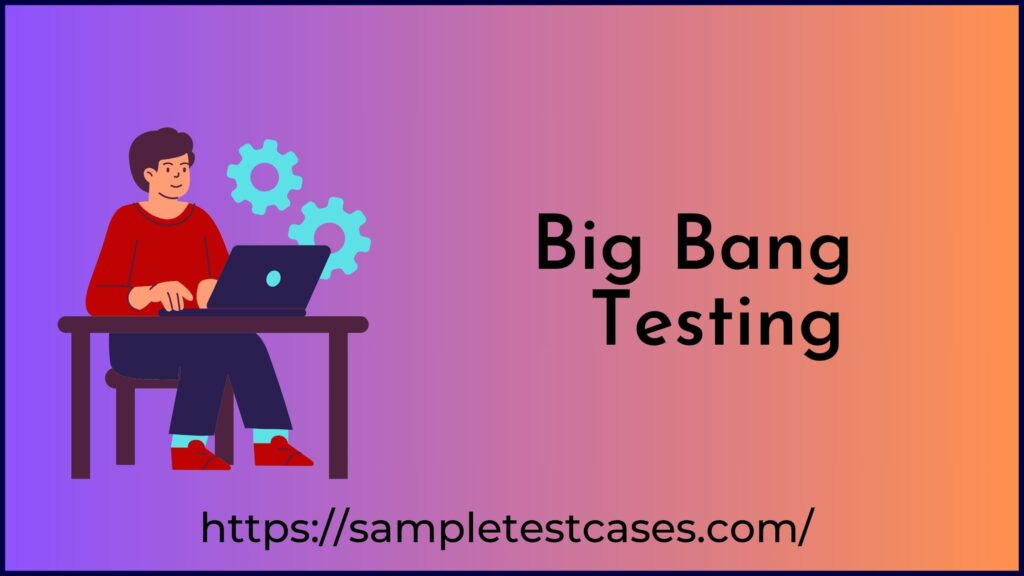In this article, we’ll delve into what Big Bang Testing is, its advantages, best practices, and scenarios where it proves to be a valuable testing strategy. In the ever-evolving landscape of software development, ensuring the quality and reliability of applications is paramount. One approach that stands out in the realm of software testing is Big Bang Testing. This methodology is known for its simplicity and efficiency in assessing the functionality and performance of software systems.
What is Big Bang Testing?
Big Bang Testing is a testing approach where all the individual components or modules of a software application are tested together, often in a single, comprehensive testing phase. Unlike other testing methods that involve incremental integration and testing of components, Big Bang Testing focuses on evaluating the entire system’s functionality as a whole.
This approach is typically employed after the individual units or modules have undergone unit testing. Once these units are ready for integration, they are combined in a “big bang,” and testing is carried out on the complete system.
Advantages of Big Bang Testing
Big Bang Testing offers several key advantages:
- Simplicity: It is straightforward and easy to implement, as it does not require the gradual integration and testing of individual components.
- Efficiency: Testing all components together can be completed relatively quickly compared to incremental testing methods.
- Early Issue Identification: It has the potential to identify major integration issues early in the development process, allowing for timely resolutions.
- Independence: Developers can work on individual components independently without needing to worry about integration until it’s time for Big Bang Testing.
- Resource Optimization: It can optimize resources as it does not necessitate maintaining complex staging environments for incremental testing.
Best Practices for Big Bang Testing
To ensure effective implementation of Big Bang Testing, consider the following best practices:
- Clear Test Objectives: Define clear objectives and criteria for a successful Big Bang Test, including the specific functionality and performance metrics you want to validate.
- Comprehensive Test Data: Prepare comprehensive test data that covers a wide range of scenarios and use cases to ensure thorough testing.
- Integration Test Plan: Develop a detailed test plan outlining the sequence of integration and specific tests to conduct.
- Logging and Monitoring: Implement robust logging and monitoring mechanisms to track the behavior of the integrated system during testing.
- Environment Simulation: Create an environment that closely simulates the production environment to replicate real-world conditions accurately.
- Rollback Strategy: Establish a rollback strategy in case significant issues identify during testing to mitigate potential risks.
- Defect Tracking: Utilize a defect tracking system to log and prioritize issues discovered during this testing for effective resolution.
Scenarios for Using Big Bang Testing
Big Bang Testing is a suitable approach in various scenarios, including:
- Small to Medium-Sized Projects: It works well for projects with a limited number of components or modules that can easily manage in a single integration phase.
- Stable Components: When individual components stable, well-test, and their interfaces well-define, minimizing integration challenges.
- Early Integration: In cases where integration occurs relatively early in the development process, allowing for early detection and resolution of integration issues.
- Rapid Development: In agile or iterative development environments, where components are continuously evolving and need periodic integration and testing.
Limitations and Considerations
While Big Bang Testing offers advantages, it is essential to be aware of its limitations:
- Risk: There is a higher risk of discovering major integration issues late in the development process, which can be more challenging and costly to address.
- Complexity: For large and complex systems, this testing can be challenging to manage, debug, and analyze.
- Limited Traceability: It may be more challenging to trace defects back to specific components, as everything integrate simultaneously.
- Resource Intensive: Addressing significant issues that arise during testing can consume significant resources and effort.
Conclusion
Big Bang Testing is a valuable approach when applied judiciously in the right context. It simplifies the integration and testing process, potentially leading to early identification of major issues. By adhering to best practices and ensuring that individual components well-test, this testing can contribute to a smoother and more efficient software development process. However, it is crucial to evaluate its suitability for the specific project and consider the potential risks and challenges associated with this testing approach.
- Big Bang model
- Big Bang Integration Testing
- Difference Between Sanity Testing Vs Smoke Testing
- Manual Testing Interview Questions
- QA Interview Questions
- QA (Quality Assurance)
- Integration Testing
- Functional Testing
- Usability Testing
- Performance Testing
- Regression Testing
- CRM Testing
- User Acceptance Testing
